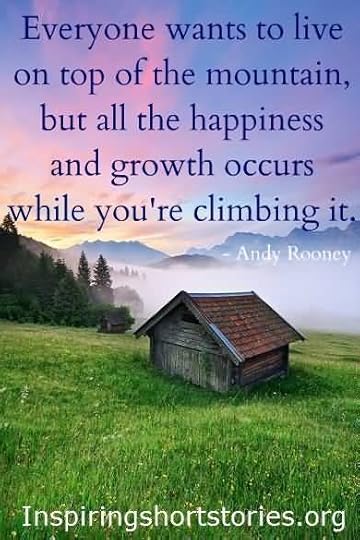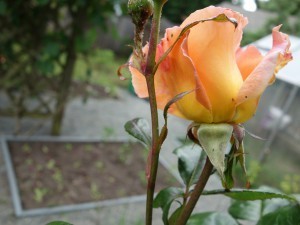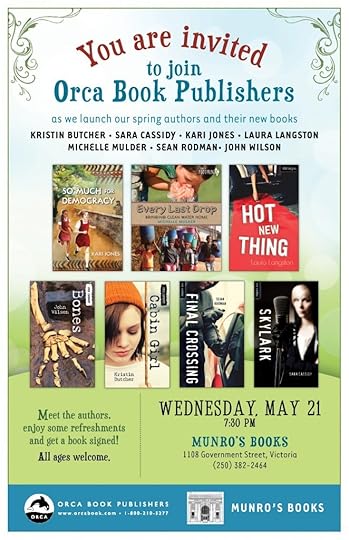Laura Langston's Blog, page 40
July 9, 2014
My July Reads
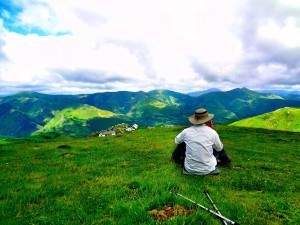 With one notable exception, I’ve been binging on non-fiction books lately. Part of it is due to the fact that I’m in a transitional phase in my current manuscript and can’t afford to distract myself with another novel (that’s polite speak for the thing is a red hot mess and I need to sort it out). But along with that, the book I’m writing, One Good Deed, seems to require it. Or maybe I require it. One of the characters is a homeless man who has spent the better part of two decades alone. At least he appears to be homeless in the opening few scenes. But he has hidden depths and a secret life that comes to light as the story progresses. So I’ve found myself drawn to introspective books over the last while. The one exception is a series of novels by Karen Robards featuring Dr. Charlotte ‘Charlie’ Stone, a psychiatrist who also sees dead people. They’re fast paced and fun, just what I need to power through a session on the elliptical.
With one notable exception, I’ve been binging on non-fiction books lately. Part of it is due to the fact that I’m in a transitional phase in my current manuscript and can’t afford to distract myself with another novel (that’s polite speak for the thing is a red hot mess and I need to sort it out). But along with that, the book I’m writing, One Good Deed, seems to require it. Or maybe I require it. One of the characters is a homeless man who has spent the better part of two decades alone. At least he appears to be homeless in the opening few scenes. But he has hidden depths and a secret life that comes to light as the story progresses. So I’ve found myself drawn to introspective books over the last while. The one exception is a series of novels by Karen Robards featuring Dr. Charlotte ‘Charlie’ Stone, a psychiatrist who also sees dead people. They’re fast paced and fun, just what I need to power through a session on the elliptical.
What I’m Reading:
On the Patio: Solitude; Seeking Wisdom in Extremes by Robert Kull
At the Gym: The Last Kiss Goodbye by Karen Robards
On the Kindle: A Journey of Days; Relearning Life’s Lessons on the Camino de Santiago by Guy Thatcher
Books read to date in 2014: 46
July 2, 2014
Simple Strawberry Pie
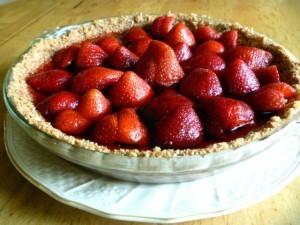 For our family, strawberry pie signals the start of summer. My mother-in-law began the tradition years ago with a simple strawberry pie my daughter fell in love with. It’s an easy, throw together dessert that’s way too high in sugar and relies on Jell-O as a key ingredient. If my daughter hadn’t asked me to take over when my mother-in-law stopped making it, it probably wouldn’t have crossed my radar.
For our family, strawberry pie signals the start of summer. My mother-in-law began the tradition years ago with a simple strawberry pie my daughter fell in love with. It’s an easy, throw together dessert that’s way too high in sugar and relies on Jell-O as a key ingredient. If my daughter hadn’t asked me to take over when my mother-in-law stopped making it, it probably wouldn’t have crossed my radar.
But she did so I do and it’s become something of a tradition to have in our house around Canada Day. That time of year when fresh strawberries are at their best. Served with vanilla ice cream or whipping cream, it mimics the red and white of the Canadian flag, which is another reason I usually make it on or around July 1st.
It’s funny how fiction and life intertwine. My current WIP features a teenage heroine who wants to be a chef. In the process of planning a special meal with fussy little tartlets for dessert, she’s forced to ditch that plan and make this strawberry pie instead.
Child’s play it is. But child’s play never tasted so good.
Butter a deep dish pie plate or tart tin and set aside (I use a Pyrex pie plate that’s 9 ½ inches/24 cm across and 2 inches/5cm deep).
Crust:
1 cup/240 mL Graham cracker crumbs
1 cup/240 mL ground almonds
1/3 cup/80 mL butter
¼ cup/60 mL white sugar
In a large bowl, mix together graham cracker crumbs, ground almonds and white sugar. Melt butter. Blend into crumb mix until it appears pebbly. Press mixture into buttered pie plate or tart tin. Freeze. The crust can be made a day or two ahead of time.
Filling:
5 cups (1.18 litres) fresh strawberries
3 oz/85 grams strawberry Jell-O
1 cup/240 mL white sugar
1 cup/240 mL water
In a medium saucepan, combine Jell-O powder, sugar and water. Bring to a boil, stirring constantly. Boil vigorously for 1 minute. Remove from heat and pour into a large bowl. Cool to room temperature (I put it in the fridge for a few minutes while I prepare the strawberries). Clean strawberries and remove green tops. Make sure they are dry. Remove cold crust from the freezer. Place strawberries inside the crust, pointed tips up. When the Jell-O mixture is room temperature, carefully pour over the strawberries. Refrigerate for an hour or two until set.
June 25, 2014
In the Middle of a Muddle
 I’m half way through the first draft of my next YA novel, One Good Deed.
I’m half way through the first draft of my next YA novel, One Good Deed.
It’s a lot like my garden. Crowded, colorful, and slightly out of control. Words and plot threads are popping up where I don’t necessarily expect them, much like the weeds and flower seedlings randomly sprouting in the garden.
Years ago, when I first started gardening, a friend who was a professional gardener told me I shouldn’t plant so heavily, that I would regret it, that it would lead to disaster as the strong, vigorous plants would crowd out the more fragile specimens. I listened, I considered, and I planted. I planted heavily because while I admire the clean lines and austerity of, say, Japanese gardens (and I’m passionate about Bonsai) I gravitate to the lush, riotous color of a blousy and overplanted cottage-style garden.
In the garden, my mantra is ‘Look here. And here. And here.’
When I write, my mantra is: ‘Then this. And this. And this.’
My books tend to overflow with people and events and details, especially in the first draft stage. Though I always start with an outline or loose synopsis, at the same time I also like to follow my instincts and the plot threads that come from that. One Good Deed has multiple plot threads. Some I conceived before I started and some are occurring to me as I write. It’s exciting, but also somewhat nerve-wracking.
In the garden, I plant what I want where I think it will work. I put some thought into it, but I don’t overanalyze. Self-indulgent as it may sound, I’m creating the space for me. I know there’ll come a time – maybe in mid-summer when the rush of the garden season is over or in fall when I’m putting things to bed for the winter –when I’ll thin things out or reposition plants or dig up volunteers to share with friends. If I don’t get to it, well there’s always next year.
I don’t feel that same sort of luxurious abandonment when I write. For one thing, writing comes with deadlines. For another, it’s not about self-indulgence, it’s about telling a story readers will love. So, even after 18 published books I fret about the tangents I’m creating, the various plot threads that may or may not weave together nicely. I’ll revise, I always do, but it’s not time effective to write so much that you need to dump a third of the manuscript in the rewriting process.
Writing a novel is a delicate balancing act. At times it’s a bit of a muddle. And I’m in the middle of it. Wish me luck.
June 18, 2014
Rewards can be a Long Time Coming
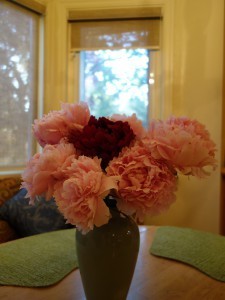 Years ago, a friend and I rescued dozens of plants from a city lot not far from where I live. The lot was being gutted in preparation for an apartment block. Over a period of weeks and with permission from the builders, we went in and dug up lilacs, hydrangeas, and reams of smaller things like California poppies and Shasta daisies. We also rescued a number of peony bushes. They were old and we weren’t sure they’d survive the move. They did, though it took years to nurse them back to productivity. But now, every spring, I’m rewarded with handfuls of blooms to bring inside. Tangible evidence, as one friend said, of the reward of hard work. Those peonies are also a reminder of my early gardening days, when I felt like anything was possible, slugs notwithstanding. Those days when the garden felt more like a blessing than a chore.
Years ago, a friend and I rescued dozens of plants from a city lot not far from where I live. The lot was being gutted in preparation for an apartment block. Over a period of weeks and with permission from the builders, we went in and dug up lilacs, hydrangeas, and reams of smaller things like California poppies and Shasta daisies. We also rescued a number of peony bushes. They were old and we weren’t sure they’d survive the move. They did, though it took years to nurse them back to productivity. But now, every spring, I’m rewarded with handfuls of blooms to bring inside. Tangible evidence, as one friend said, of the reward of hard work. Those peonies are also a reminder of my early gardening days, when I felt like anything was possible, slugs notwithstanding. Those days when the garden felt more like a blessing than a chore.
Coincidentally, I’ve spent the last few months revisiting and readying for publication an adult novel I wrote years ago. Much of it was done when my daughter napped, and after I’d spent the morning writing magazine articles or assembling radio documentaries. Back in the days when I felt like anything was possible, publishing climate notwithstanding. Those days when the writing felt more like a reward instead of a responsibility.
At some point in the coming months I hope to have “What Lainey Sees” uploaded and for sale under my other writing name – Laura Tobias. When it hits the Amazon shelf, it will be tangible evidence of the reward of hard work. And the pleasure of the journey itself.
June 11, 2014
The Creative Art of Doing Nothing
 I don’t have much time for lying on the grass and watching the clouds these days. You probably don’t either. Do you care? Or does some small part of you celebrate the fact that your life is busy, busy? That it’s always go, go, go?
I don’t have much time for lying on the grass and watching the clouds these days. You probably don’t either. Do you care? Or does some small part of you celebrate the fact that your life is busy, busy? That it’s always go, go, go?
Benjamin Franklin said, “It is the working man who is the happy man. It is the idle man who is the miserable man.” Most of us have taken that attitude to heart. We’ve also adopted the belief that “Inspiration exists but it has to find you working” (Pablo Picasso) and that ‘Idle hands are the devil’s playthings.’ (That quote is so rampant and has so many variables no one is entirely sure where it first came from).
In our culture we celebrate busyness. Busyness equals business. If you aren’t busy, you aren’t doing business.
Except:
“To do great work one must be very idle as well as very industrious.” Samuel Butler
And:
“Imagination needs moodling – long inefficient happy idling, dawdling and puttering.” Brenda Ueland in If You Want to be a Writer
Moodling isn’t watching TV or seeing a movie. It’s not surfing the net or reading a book. It’s not cooking a meal for someone you love or listening to a friend in trouble, or even walking the dog if that dog is anything like my youngest (lovable but demanding) Sheltie. Those things are all worthwhile. But they’re not moodling.
Moodling is
. . . watching a spider eat aphids on a rose.
. . walking the beach with no agenda and only your thoughts for company. 
. . . sitting outside after dark and staring at the stars not because you’re locked out but because you want to lock in. To inspiration. To creativity. And to possibilities.
We all need a little moodling time. It’s the best way to let our imaginations soar.
June 4, 2014
My June Reads
 The vegetable garden is planted and my chiropractor is several hundred dollars richer. Between rain days and other commitments, I’d let the beds go a little too long this year. The weeds were tenacious, the soil still on the heavy side, and my back and hips didn’t appreciate it. Needless to say, by the end of each day, I was ready for a hot bath, a cold drink and a good book. In fact, there were moments with the sweat rolling down my forehead that all I could think about was the book waiting for me inside. It was a good reminder of the simple joy a book can bring.
The vegetable garden is planted and my chiropractor is several hundred dollars richer. Between rain days and other commitments, I’d let the beds go a little too long this year. The weeds were tenacious, the soil still on the heavy side, and my back and hips didn’t appreciate it. Needless to say, by the end of each day, I was ready for a hot bath, a cold drink and a good book. In fact, there were moments with the sweat rolling down my forehead that all I could think about was the book waiting for me inside. It was a good reminder of the simple joy a book can bring.
Here’s what I’m reading these days:
On the Kindle: The Misremembered Man by Christina McKenna
At the Gym: Unraveling Isobel by Eileen Cook
Beside the Bed: The Rosie Project by Graeme Simsion
Books read to date in 2014: 36
May 27, 2014
Tag, You’re It!
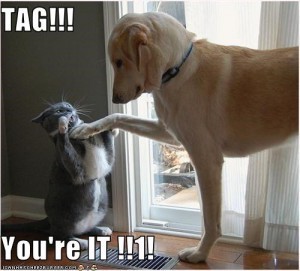 My friend, author Kristin Butcher, invited me to be part of a virtual game of blog tag. The process is simple – we answer a few questions about writing and tag three other authors to do the same a week or two later.
My friend, author Kristin Butcher, invited me to be part of a virtual game of blog tag. The process is simple – we answer a few questions about writing and tag three other authors to do the same a week or two later.
Thanks for the invite, Kristin! I met Kristin years ago when we were on a panel at a local high school talking about our writing process. We became friends. Though Kristin lives on the northern part of the island and I live on the southern tip, we stay in touch through emails, Facebook, and occasional face-to-face coffees or lunches. Find out more about Kristin’s writing here: http://www.kristinbutcher.com/
I’ve tagged three other writing friends to follow me: Lisa McManus Lange, Jacquie Pearce and Nikki Tate. Look for their posts around June 2nd.
And now to the questions:
What am I working on?
I generally juggle two or three projects at once, sometimes more if I have a magazine article deadline. I just finished page proofs for THE ART OF GETTING STARED AT, which will be out this August. With Penguin’s support, I’m about to tackle my first ever book trailer. That’ll be fun and a whole new thing for me! I’m in the middle of writing another YA novel called ONE GOOD DEED. It’s about a sixteen-year-old girl who saves a man’s life. The fallout from that one good deed has long-ranging and potentially disastrous consequences. And I’ve just signed a contract with Orca Book Publishers to write another book in their Limelights Series – this one tentatively titled STEPPING OUT.
I also write fiction for adults under the name Laura Tobias. In the next few months, I’ll be releasing my first adult novel called WHAT LAINEY SEES. It’s a romantic suspense with a Native American time travel element, so it’s essentially two stories in one. This book has been in the works for quite a long time and I’m excited that it’s finally coming out. Once that’s released, I’ll be revising another Laura Tobias title: GIRLS WHO DISH. It’s a contemporary story about a lottery win told from three points of view: one teenage girl and two adults.
How does my work differ from others of its genre?
That’s a hard question to answer. I write in multiple genres: young adult and adult novels, middle grade fiction, picture books, and non-fiction for both adults and kids. So I suppose my versatility sets me apart from some authors.
I’ve also been told I have a fairly distinct voice. Because I write for different age groups, I work hard to ensure the voice and attitudes for each particular book remain true to the age and maturity level for that genre. A fifteen-year-old protagonist thinks differently from a five-year-old who thinks and acts differently again (or one would hope!) from a 35-year-old.
Finally, while I love uplifting stories and try to end most books on a hopeful note, I’m not afraid to tackle painful or controversial subjects like sperm donor children or memory loss or Canada’s internment of Ukrainians during World War One.
Why do I write what I do?
I wish I knew! Seriously, I sometimes wish I had a passion for just one subject because I think it’s easier to build a readership that way. If I wrote only young adult or mystery or adult contemporary novels, people would know what they were getting when they opened a Laura Langston or Laura Tobias book. But I’m all over the map. Life is fascinating. People are fascinating. Research is fascinating. I go where my curiosity takes me. And it takes me in many directions.
How does my writing process work?
I’m a morning person so in terms of my daily routine, I do my fresh writing in the morning and if I’m on a roll, I’ll continue with it after lunch. If I’m feeling bogged down on the current work-in-progress, I’ll switch gears in the afternoon and work on an article or a blog post, or on a novel that’s in revision stage. Lately I’ve been doing a lot of my writing on a treadmill desk. It was surprisingly easy to adapt, and it really boosts creativity.
In terms of ideas, I have more ideas than time. I keep an idea file but when I finish one book I usually know which one will come next. It’s the one that’s calling the loudest!
Before I do any actual writing, I noodle around with characters, goals and motivation. I need to know what’s at stake and I like to have an idea of my final destination – the climax and how the story will end (though that’s open to change and often does!) Sometimes I write a longish outline, chapter by chapter, but other times I have a shorter roadmap of sorts. Either way, I almost always write a mock back cover book blurb early on to help me stay focused.
I revise as I go, reading over what I wrote the day before and briefly tweaking it before jumping into the story again, and I almost always revise afterwards too. I generally set my manuscripts aside for a few weeks, go back to them, and see places that need tightening or character arcs that need to be better developed. I love the revision process, particularly after a full draft; that’s when the story coalesces for me. But I have one annoying habit: I need to nail and polish the first three or four chapters early on. If something isn’t working in those beginning chapters I come to a total stop. It’s crazy because I’ll often revise those early chapters again later, but if they don’t work for me at the start, I can’t go forward. It’s almost like I’m packing a suitcase for a trip and I need to be organized with everything at hand before I leave. Once I’m happy with the start of the journey, I’m open to whatever comes up!
Three authors to watch for:
I met Lisa McManus Lange at a writing craft session put on by Romance Writers of America. Lisa routinely gets up at 4 or 5 every morning to exercise and write before starting her day job. She’s the proud and active parent of two sons, a regular blogger, and one of the most dedicated and productive writers I know.
Lisa McManus Lange (www.lisamcmanuslange.blogspot.com) has been writing slice-of-life stories for over 12 years. Multi-published with Chicken Soup for the Soul and anthologies by Publishing Syndicate, her newest writing adventure has led her to having her first novel for young adults published by Lycaon Press as an ebook. ‘Newbie Nick’ will be released on June 18th and you can read about it more at www.lisamcmanus.com
I met Jacquie Pearce at a CWILL event in Vancouver years back, and while I don’t remember the specific time or group we were addressing, I remember the book she was introducing – Weeds and Other Stories. I was so taken by her reading that I bought the book and devoured it on the ferry trip home. I’ve been a huge fan of her writing ever since.
Jacquie Pearce writes fiction for kids and teens. Her recent chapter book, Flood Warning, tells the story of a boy and his dog during the Fraser River flood of 1948. Her newest novel, Siege, about a teenage boy who stumbles across criminal activity in the middle of a War of 1812 re-enactment, will be out this fall. Blog: wildink.wordpress.com Website: jacquelinepearce.ca
The first time I saw Nikki Tate present to children I knew I was witnessing a formidable talent. Whether she’s wearing her author hat, her storytelling hat, her reviewing hat, or her farming hat, Nikki brings her complete focus to everything she does. She’s also full of useful recommendations – everything from the best YA read of the season to the perfect tax accountant!
Nikki Tate is the author of more than twenty books for young readers. She enjoys working in all genres and age groups (picture books, juvenile fiction, teen fiction, historical fiction, fantasy novels, biography, and non-fiction) and for all age groups. When she isn’t writing, Nikki keeps busy raising rare heritage breeds of farm animals on her small farm on Vancouver Island. For more information visit her author website at www.nikkitate.com or check out what’s going on down on the farm by reading her farm blog at www.darkcreekfarm.com/blog
May 20, 2014
It’s Time for a Party!
I’m busy writing a speech for tomorrow’s book launch sponsored by Orca Book Publishers. If you’re in the Victoria area, join us at Munro’s Books at 7:30 on Wednesday, May 21st as we formally introduce our spring book titles. I’ll be there talking about Hot New Thing. Joining me will be John Wilson, Kristin Butcher, Sara Cassidy, Kari Jones, Michelle Mulder and Sean Rodman.
Drop by, enjoy a snack, and get a book signed. We’d love to see you!
May 14, 2014
To Look . . . and to Really See
“ In my own worst seasons, I’ve come back from the colorless world of despair by forcing myself to look hard, for a long time, at a single glorious thing: a flame of red geranium outside my bedroom window. And then another: my daughter in a yellow dress. And another: the perfect outline of a full, dark sphere behind the crescent moon. Until I learned to be in love with my life again. Like a stroke victim retraining new parts of the brain to grasp lost skills, I have taught myself joy, over and over again.”
Barbara Kingsolver
 Sight is often taken for granted. It’s relatively rare to recognize how much joy sight brings to our lives. I certainly don’t get up every morning and celebrate the sight I see in the bathroom mirror (though I do smile when the alarm goes off and I see the furry bodies of Team Sheltie pouncing on the bed for a morning cuddle).
Sight is often taken for granted. It’s relatively rare to recognize how much joy sight brings to our lives. I certainly don’t get up every morning and celebrate the sight I see in the bathroom mirror (though I do smile when the alarm goes off and I see the furry bodies of Team Sheltie pouncing on the bed for a morning cuddle).
I’ve been thinking about sight a lot lately. I’m at the hospital waiting while my mother has the first of two surgeries to remove cataracts from her eyes. The world is becoming cloudier on a daily basis, she says. She stopped driving at night many months ago, and she admitted last week she shouldn’t be driving during the day now either.
The surgery has an extremely high success rate, so there’s no reason to worry. But sight is a subject fraught with emotion in our family. Growing up, I watched as my grandmother slowly went blind. She had diabetes, and though she went through multiple surgeries, there was nothing the doctors could do to stop the inevitable. She took it in stride, and with amazing grace, though it left her angry and depressed at times. My mother – her daughter – also has diabetes. Her eyes are showing signs of damage that cataract surgery cannot address. The upside, if there is one, is that while my grandmother spent most of her adult life as a diabetic and her eyes bore much of the damage, my mother was diagnosed much later in life. There is still time for her to see another sunset, watch a grandchild get married, perhaps even look into the eyes of her first great- grandchild. With luck, her eyesight will remain reasonably good for a long time.
But there are no guarantees in life. My mother’s surgeries, and memories of my grandmother, have given me a deeper appreciation of what’s around me this spring. In the back garden, the red tulips with blue and white throats are almost finished. The lovage has shot up in the herb garden; the celery-like stalks are almost five feet high. And beside the house, the lilac bush is heavy with richly-scented purple blooms. I’ve cut some for my desk. Every once in a while I stop to admire them. Not only is it important to stop and smell the flowers, it’s just as important to stop and see them too.
May 7, 2014
Character Motivation: What Were You Thinking?
 I’ve been stunned lately over the actions of some people I know. They’ve done things and made decisions that were dumb less than inspired. More than once I’ve turned to Mr. Petrol Head and asked, “What was she thinking?” In the time it takes him to shrug, I’ve mentally crafted up a list of possible motivations because, for me, trying to figure out why people act the way they do is as natural as breathing.
I’ve been stunned lately over the actions of some people I know. They’ve done things and made decisions that were dumb less than inspired. More than once I’ve turned to Mr. Petrol Head and asked, “What was she thinking?” In the time it takes him to shrug, I’ve mentally crafted up a list of possible motivations because, for me, trying to figure out why people act the way they do is as natural as breathing.
In fact, we don’t usually know what motivates friends and family. We don’t always understand our own motives either. But when it comes to creating characters in our books, we’d better know the why of their actions.
Dwight Swain, in his terrific book Creating Characters, says the thing we all seek, at our core, is happiness. Once our physical needs are satisfied, he believes happiness comes from a sense of self-worth or self-importance. To that I would add a sense of safety, and for some people that means maintaining the status quo and avoiding change at any cost. So figure out what makes your character happy, what gives their life meaning, what’s important to them. Then introduce a threat to their sense of self or their life circumstances, or dangle something they want in front of them. Give them a reason – a motive – for wanting to either seize the opportunity or avoid the threat. Make that motive deeply personal and unique to them. Add in conflict (something to prevent them from reaching their goal) and you have a page turner.
Easy right?
Well, it sounds easy but it’s actually a brain bender that can take days to figure out. For me, the gold standard in working through these issues is outlined in Debra Dixon’s book Goal, Motivation, and Conflict. Tightly focusing on what a character wants, why they want it, and what’s preventing them from having it, gives any story shape, form and urgency. And those are all things we need in fiction.
One last suggestion – if you’re looking to real life for inspiration, be warned. Yes, people do crazy things and make bad decisions. Often those actions seem unmotivated. Or the motives are so deeply hidden you’d need an excavator to uncover them. But when it comes to fiction, make sure you understand why your characters are taking (or not taking) action, even if they remain blind to their own motives. And make sure your reader understands too.
Because fiction needs to make sense. Even if life doesn’t.



